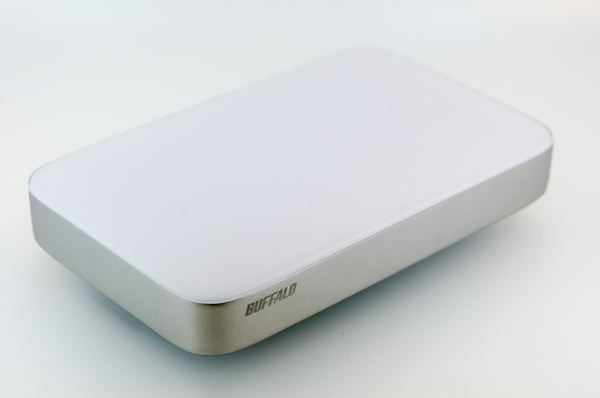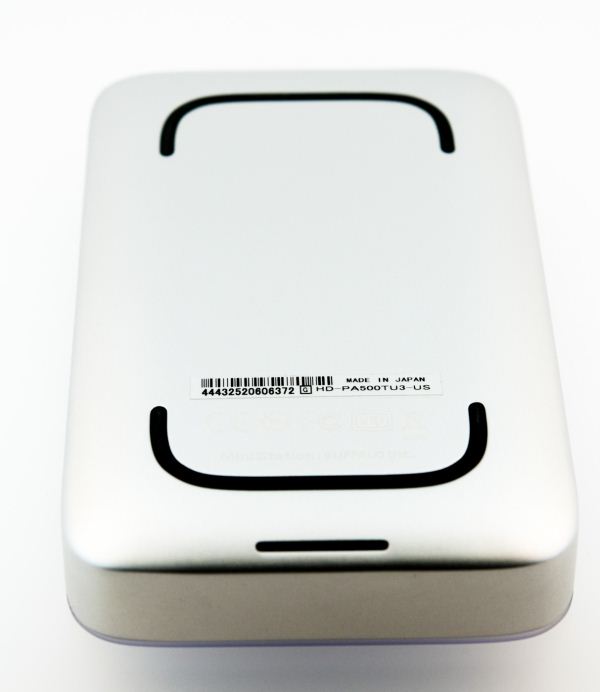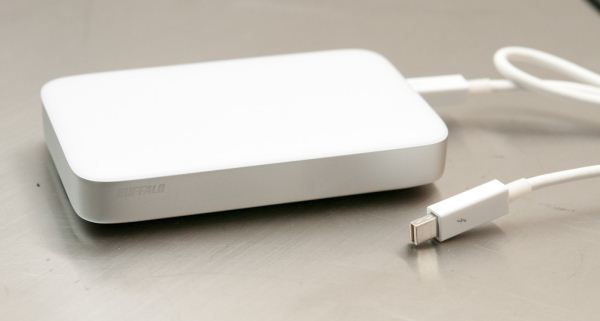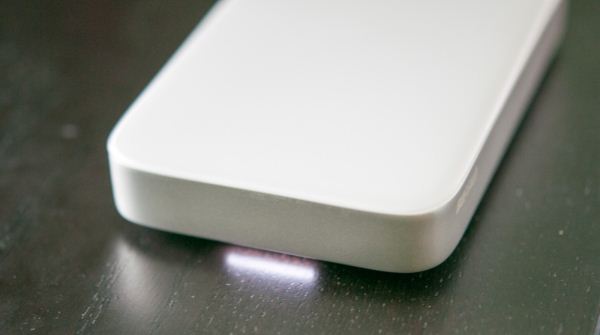Buffalo MiniStation Thunderbolt Review - An External with USB 3.0 and Thunderbolt
by Brian Klug on August 1, 2012 4:04 PM EST- Posted in
- Storage
- SSDs
- USB 3.0
- Thunderbolt
- Buffalo
Back when Thunderbolt (then Intel Lightpeak) was optical, I was actively involved in covering the interface, partly out of professional curiosity due to my optical background, partly because I sincerely believe optical interfaces are an inevitable part of the future. When Lightpeak became Thunderbolt and lost the optical layer, it fell under Anand’s beat and the Mac umbrella. I acquired a MacBook Pro with Thunderbolt somewhere around the same time, but never acquired any Thunderbolt peripherals or drives. Since then, Thunderbolt has slowly but surely gained traction with more and more peripherals and host devices. Initial adoption was glacial in part because most of the earliest Thunderbolt peripherals were really aimed at the very high end market with big RAID or JBOD stations, and partly due to what boiled down to Thunderbolt being Apple-only until just recently.
There’s an interesting story as to exactly why most of the initial Thunderbolt peripherals were aimed at such a high-end market, and some of it was purely because of both the TDP, size, and engineering constraints involved with the first generation Thunderbolt controllers. The other half of the equation is that selling external storage isn’t always the most valuable prospect, as shoppers expect commodity pricing and generally know the cost of the drive inside. Thankfully, second generation Thunderbolt controllers with smaller size, TDP, and lower cost are now the norm, and at the same time Apple has unleashed more Macs with the interface of note, meaning that there’s a bigger captive market of potentially interested shoppers.
So when Buffalo dropped us a line about an upcoming 2.5" form factor portable hard drive with both USB 3.0 and Thunderbolt interfaces, I couldn’t resist the temptation and jumped at the opportunity to review it. When it comes to single drive external Thunderbolt storage, the only real options at this point are either the Seagate GoFlex, or the new Buffalo MiniStation Thunderbolt.
The Buffalo MiniStation comes in two flavors, differentiated only in storage size. There’s a 1 TB version which runs $229.99 named the HD-PA1.0TU3, and a 500 GB version named the HD-PA500TU3 and priced at $199.99. The only difference is what drive you get inside; both include Thunderbolt and USB 3.0. Buffalo has also opted to include both the USB 3.0 and Thunderbolt cables with both MiniStations. Prior drives required the separate purchase of a Thunderbolt cable, which costs around $50. Since there are now multiple cable suppliers (whether this means the active controller in the cable, or companies cabling the system remains unknown to me), pricing has started creeping down and Buffalo was able to include both a 19.7 inch Thunderbolt cable and USB 3.0 cable.
| Buffalo MiniStation Thunderbolt | |||||
| HD-PA500TU3 | HD-PA1.0TU3 | ||||
| Storage | 500 GB HDD | 1 TB HDD | |||
| Interface | miniUSB 3.0 (2.0 legacy), Thunderbolt (no pass through), Cables Included | ||||
| Formatting | Mac (HFS+) | ||||
| Size, Mass | 3.17 x 5.12 x 0.91 (inches), 9.28 oz | ||||
| Pricing | $199.99 (newegg) | $229.99 (newegg) | |||
Since Thunderbolt is still predominantly an Apple interface (7-series boards and IVB Ultrabooks notwithstanding), the industrial design of the Buffalo MiniStation is decidedly Apple inspired. The drive is made of two main parts, a single piece aluminum can in which the drive sits, and a plastic top which snaps inside this assembly.
There’s a series of white status LEDs which shine through a diffuse rectangular chicklet cutout on the bottom front lip, which reflects up off of a surface. The indicator light breathes like an Apple power indicator when there’s activity, and stays solid when plugged in. It’s a nice take on an external hard disk status LED that I haven’t seen done before.
On the underside are two small rubber feet which actually aren’t part of the aluminum base but make contact with the drive caddy inside. Regulatory markings are laser etched near the front rubber foot. At the back of course are the Thunderbolt and USB 3.0 ports, on opposite sides of the drive.
Construction of the MiniStation is subjectively great. There’s not much flex if you squeeze the aluminum side against the plastic lip, and it feels like a solid brick of aluminum in the hand. I’ve regularly transferred videos shot on my DSLR onto the MiniStation, then tossed the drive into the main pocket of my backpack. It isn’t a super rugged design, but definitely will get the job done.





















61 Comments
View All Comments
Calista - Thursday, August 2, 2012 - link
Compare it to the USB2 numbers. It's a huge difference. This product is designed to fit well with Apple users where you can expect potential hosts to support Firewire, USB2, USB3 and/or Thunderbolt.USB2 and Firewire is more or less the same, and USB3 has been with Apple for only a short while. So we have a situation where both TB and USB3 equipped Macs can expect superior speed while still being backward compatible with any Mac from the last century.
If choosing a USB3-only solution only a Mac only a handful of computers would support it (rMBP being the first) while TB was first included 18 months ago.
I'm not saying it's a perfect solution, but for the "right person" it's a solution superior to a pure USB3-interface.
Sm0kes - Thursday, August 2, 2012 - link
Judging by the comments -- the "right person" is a very small minority, which underscores the disappointment with this and all previous Thunderbolt enclosures released to date.Until a bare enclosure like this comes out at cheaper price point (~$60 - $80), these will be niche products.
C'DaleRider - Wednesday, August 1, 2012 - link
You're using a trademarked shape, the rectangle. Apple may want a word with you.name99 - Wednesday, August 1, 2012 - link
Oh you're so witty! And really adding to the conversation...MarsMSJ - Wednesday, August 1, 2012 - link
I have a 13 " MBP Early 2011 and I only have two options, thunderbolt or USB 2.0. These drives are awesome especially since they include the thunderbolt cable. Apple sells this cable for 50USD. These drives are great for me and my VM (VMs wreck consumer ssd's.)name99 - Wednesday, August 1, 2012 - link
"Port Ridge is popping up in a lot of places, for good reason - it’s inexpensive, second generation, small, and has a low TDP."Damn, our standards are pretty undemanding in this space, aren't they.
IMHO .7W is massive --- let's recall that we expect a USB2 drive of this sort to run comfortably off 2.5W.
Of course this will fall in time, but until then let's not pretend a pig in lipstick is Cindy Crawford. .7W sucks, and we better hope Intel does better than reduce it by factor of 2 for the next rev.
[As a secondary issue, what's with this idiotic fad for no-pass-through drives? IF we lived in a world where TB hubs actually existed, it would make sense. But since these hubs don't appear to exist, and Buffalo, for example, is not filling the vacuum, creating a device of this form is just idiotic. The already minuscule pool of people willing to buy a device like this is mostly people who
(a) have plenty of peripherals and
(b) were burned the last time round by FW800, with its lack of hubs and its peripherals that all shipped with no pass through.
Honestly at this point I hope either Intel or Apple just do an MS Surface and say "screw 3rd part vendors. These people are so damn incompetent they're making our product look bad, and WTF cares if our competition bankrupts them --- they damn well deserve it}.]
ggathagan - Thursday, August 2, 2012 - link
Setting this up as a passthrough-capable drive would increase the price (more expensive controller), increase the complexity of the circuit design and raise the TDP to at least 2.8w.That would make little sense for Buffalo, given the "already minuscule pool of people " you describe.
If and when TB has a more pervasive presence, I would expect to see pass-through designs. At this point, however, I'd say Buffalo's playing it smart.
The same holds true for the choice of hard drive. Not only are they the 1st to market with a relatively low cost TB external drive, but the drive choice means no external power is needed.
If it proves to be popular, adding additional drive options, as well as just the enclosure, will be very easy.
That's a win-win at this point in time.
jacobdrj - Thursday, August 2, 2012 - link
I have been wanting there to be a Thunderbolt SATA Enclosure for a while now. Reason being: On all the new MACs, I would be able to upgrade everyone's computers without cracking open their system, voiding their warranty, and all a lot faster, just by implanting an umbilical-ly connected SSD via Thunderbolt.I have at least 3 customers this would have made easy jobs of...
repoman27 - Thursday, August 2, 2012 - link
Opening the case does not void the warranty on most Macs, AFAIK. But if you are concerned, you can always take the test to become an Apple Certified Mac Technician. It's not terribly expensive to do, and then you don't have to worry at all.sudokill - Thursday, August 2, 2012 - link
Why are the sequential and some of the random read/writes slower on USB 3.0?? I would assume neither of the interfaces are being saturated by even the SSD. Is it more a OSX/Win 7 Issue?? I was expecting them to be more or less the same